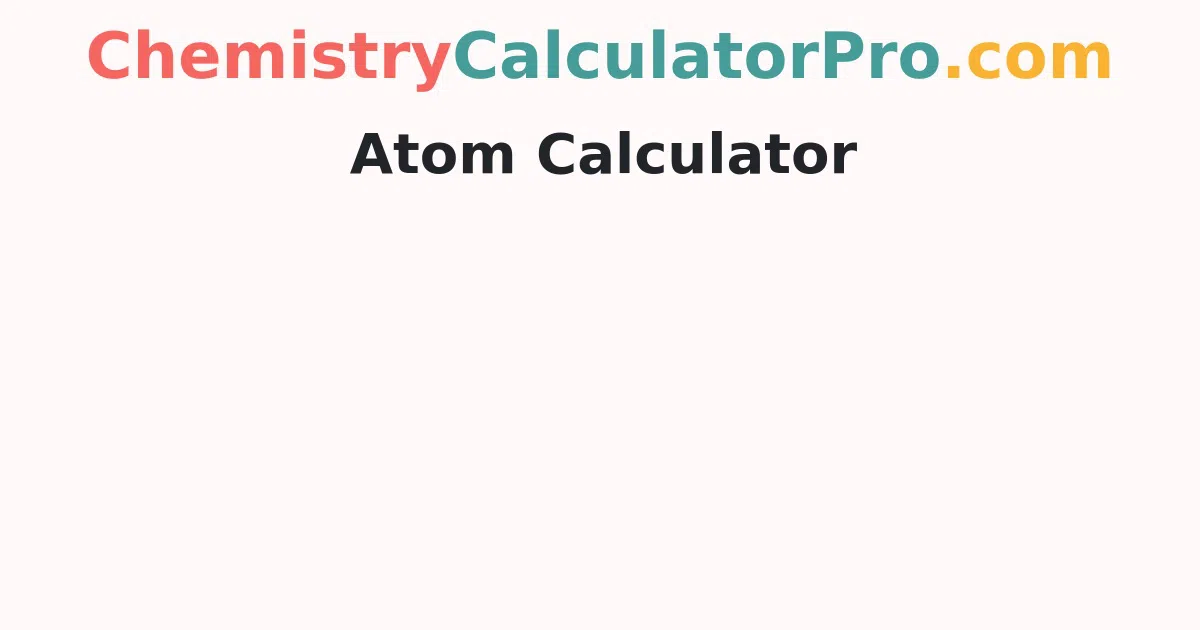Atom Calculator
Our Atom Calculator identifies the components of an atom based on the atomic number. All calculations will be sped up, and an answer will be provided in a matter of seconds. To determine the number of protons, neutrons, and electrons in seconds, simply enter the atomic number, atomic mass number, and charge of the atom into the input boxes and press the calculate button.
What is the difference between an atom, an atomic number, and an atomic mass?
Atoms are the fundamental building components of matter. It is the lowest constituent unit of matter that possesses chemical element qualities. Positively charged protons, negatively charged electrons around the nucleus, and electrically neutral neutrons in the nucleus are the components of an atom. Because they have an equal number of protons and electrons, atoms are electrically neutral.
An atom has an electrical charge if it has an uneven amount of protons and electrons. A positively charged ion is referred to as a cation because it has more protons than electrons. Otherwise, it's termed an anion because it's negatively charged.
The atomic number is the only way to identify an atom. It refers to the number of protons in the nucleus. The atomic number of uncharged atoms is equal to the number of electrons.
The mass number of an atom is calculated by adding the number of protons and neutrons. Because both protons and neutrons are present in the nucleus of an atom, they are referred to as nucleons.
Atom Components Formulas
Protons, neutrons, and electrons are the different components of an atom. Here are the formulas for calculating them
- A = Number of Protons
- M - A = Number of Neutrons
- M - C = Number of Electrons
Where, M = Mass Number, A = Atomic Number, C = Charge
How do you find out the atomic number, mass, and charge, as well as the number of protons, neutrons, and electrons?
You can compute the number of protons (p), neutrons (n), and electrons (e) using the following mathematical equations (1-3) if you know the atomic number (Z), atomic mass (A), and charge (z).
- Z = p (1)
- n = A - Z (2)
- e = Z - z (3)
However, knowing the number of protons (p), neutrons (n), and electrons (e) allows you to compute the atomic number (Z), atomic mass (A), and charge (z) (equations (4-6)).
- p = Z (4)
- A = p + n (5)
- z = p - e (6)
How to Use Atom Calculator?
The following is the procedure how to use the grams to atoms calculator
- Step 1: Fill in the appropriate input fields with the atomic number, atomic mass number, and charge of the atom and x.
- Step 2: To receive the result, click the "Calculate x" button.
- Step 3: Finally, the output field will show the number of protons, neutrons, and electrons.
How can you find out how many protons, neutrons, and electrons there are in a molecule?
Follow the easy methods below to determine the atomic components using the atomic number and mass.
- Step 1: The atomic number, mass number, and charge should all be checked.
- Step 2: The number of neutrons is calculated by subtracting an atomic number from the mass number.
- Step 3: The number of protons is equal to the atomic number.
- Step 4: The number of electrons is calculated by subtracting the charge from the atomic mass.
FAQ’s on Atom Calculator
1. How can you find out how many atoms there are?
To find out how many atoms are in a sample, divide its weight in grammes by the amu atomic mass from the periodic table, then multiply by Avogadro's number: 6.02 x 10^23
2. What is the formula for converting atoms to grammes?
The total number of atoms is multiplied by the average atomic mass of the atoms to convert atoms to grammes.
3. How many atoms does oxygen contain?
Two atoms make up an oxygen molecule. Living organisms require oxygen, which is a colourless, odourless, and tasteless gas.
4. A gas has how many atoms?
For any given temperature and pressure, 1000 atoms in a gas occupy the same space as any other 1000 atoms.
